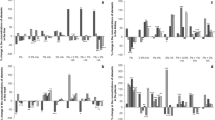Abstract
Two experiments were conducted with day-old broiler chicks reared to 18 or 19 d of age. The objectives were: (1) to examine the effects of the antioxidant ethoxyquin (EQ) on peroxidation in feeds containing fish oil (FO) or lead (Pb), and (2) to determine whether systemic effects of Pb, which are attributed to tissue peroxidation, can be reversed by dietary EQ. Experiment 1 was a 2 × 2 factorial arrangement with the factors being 4% dietary cottonseed oil (CSO) vs FO and dietary Pb as lead acetate trihydrate (0 vs 1000 ppm). Feed was mixed 1 d prior to initiation of the experiment and stored at 4°C until it was placed in the feeders. Experiment 2 was a 2 × 2 × 2 factorial arrangement with the factors being 3.5% dietary oil (CSO vs FO), dietary Pb (0 vs 1000 ppm), and EQ (0 vs 75 ppm). Feed was mixed 1 d prior to initiation of the experiment and held at room temperature thereafter. Growth depression by FO and Pb was less pronounced in Experiment 1 than in Experiment 2. In Experiment 2, FO and Pb increased the concentration of feed peroxide, and the increases were prevented by EQ. The growth depression by FO was completely reversed by EQ. EQ reversal of Pb-induced growth depression, although substantial, was not complete. The FO diet without Pb had a peroxide content (12.4 meq/kg feed) similar to the CSO +Pb diet (12.3 meq/kg feed); however, growth was not similar (407 vs 213 g body weight at 19 d respectively). The results suggest that the toxic effects of Pb are mediated by peroxidative alterations both in the feed and in tissues. The ability of EQ to reverse significantly Pb effects on growth suggests a systemic action of this antioxidant.
Similar content being viewed by others
References
O. A. Levander, V. C. Morris, and R. J. Ferretti,J. Nutr.107 363–372 (1977).
M. Sifri and W. G. Hoekstra,Fed. Proc. 37 (Abstr.), 757 (1978).
E. R. Ramstoeck, W. G. Hoekstra, and H. E. Ganter,Toxicol. Appl. Pharmacol. 54 251–257 (1980).
W. E. Donaldson and T. K. Lemming,Toxicol. Appl. Pharmacol. 73 119–123 (1984).
W. E. Donaldson,Biol. Tr. Elem. Res. 7 255–262 (1985).
L. J. Lawton and W. E. Donaldson,Biol. Tr.Elem. Res.,28, 83–97 (1991).
J. F. Mead,Free Radicals in Biology Academic Press, New York, NY (1976).
N. T. Christie and M. Costa,Biol. r. Elem. Res. 6, 139–158 (1984).
M. C. Cabel, P. W. Waldroup, W. D. Shermer, and D. F. Calabotta,Poultry Sci. 67 1725–1730 (1988).
J. U. Skaare and E. SolheimXenobiotica 9 649–657 (1979).
D. M. Latta and W. E. Donaldson,J. Nutr 116, 1561–1568 (1986).
National Research Council,Nutrient Requirements of Poultry, Natl. Acad. Sci., Washington, DC (1984).
G. L. Ellman,Arch. Biochem. Biophys. 82, 70–77 (1959).
AOAC Official Methods of Analysis. p. 507 (1984).
J. T. Helwig and K. A. Council,SAS User's Guide, Statistical Analysis System Institute, Inc. Cary, NC (1979).
S. Krishnamurthy and S. G. Bieri,J. Nutr. 77, 245–252 (1962).
I. Bartov and S. Bornstein,Poultry Sci. 60, 1840–1845 (1981).
B. Chance, A. Boveris, Y. Nakase, and H. Sies,Functions of Glutathione in Liver and Kidney, Springer-Verlag, New York, NY (1978).
S. O. Knowles and W. E. Donaldson,Comp. Biochem. Physiol. 95C, 99–104 (1990).
C. McGowan and W. E. Donaldson,Biol. Tr. Elem. Res. 10, 37–46 (1986).
R. A. Leedle and S. D. Aust,Lipids 25, 241–245 (1990).
Author information
Authors and Affiliations
Additional information
Use of trade names implies neither approval by the North Carolina Agricultural Research Service of products named nor criticism of products not named.
Rights and permissions
About this article
Cite this article
Donaldson, W.E. Interactions of dietary lead with fish oil and antioxidant in chicks. Biol Trace Elem Res 31, 215–222 (1991). https://doi.org/10.1007/BF02990192
Received:
Accepted:
Issue Date:
DOI: https://doi.org/10.1007/BF02990192



